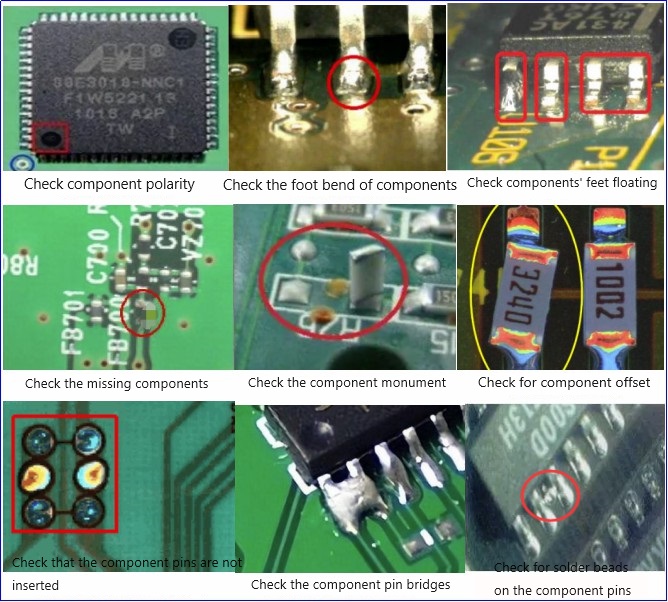AOI, Automated Optical Inspection, AOl has the functions of component inspection, PCB board inspection, solder component inspection, etc. It is based on the optical principle to detect the common defects encountered in the production of soldering equipment. A commonly used inspection method in the production of SMT is mainly through the camera and image processing technology to detect the PCB board component placement position and solder joint shape and solder paste for defects, etc. AOI inspection can be a real-time inspection of the quality of the board on the production line to improve production efficiency and solder quality to ensure product quality. AOI is a common inspection method used in SMT production: it is mainly used to detect the placement position of components on PCB boards, the shape of solder joints, and whether there are defects in the solder paste through cameras and image processing technology.
Why do we need AOI?
With the development of the circuit board manufacturing industry, PCB design tends to high-density interconnection, that is, the reaction to the PCB size on the obvious change is the size of the smaller, PCB has hundreds of thousands of soldering points, which is very easy to have problems. To minimize the probability of problems occurring, manual inspection is no longer an effective solution to the problem, with the increasing demand for products in the market, to ensure high-quality products, the a need for a very fast, very reliable and fast method of bringing high-quality products to market. Automated Optical Inspection (AOI) is an essential tool in an integrated electronics test strategy, ensuring costs are kept as low as possible by detecting faults early in the production line.
AOI uses visualization to monitor printed circuit boards for defects. They can detect surface feature defects such as nodules, scratches, and smudges, as well as more common dimensional defects such as open circuits, short circuits, and solder thinning. They can also detect incorrect components, missing components, and misplaced components. As a result, AOIs can perform all of the visual inspections previously performed by manual operators and do so much more quickly and accurately. This is accomplished by using a vision system to scan the board's surface. The system is illuminated by several light sources and uses one or more high-definition cameras. In this way, the AOI equipment can create an image of the circuit board.

pcba aoi inspection
The image acquisition system for AOI consists of three main components: the photoelectric conversion camera system, the illumination system, and the control system. Components and items that can be inspected by AOI:
1. Detectable component types
Rectangular chip components (0805 or larger): AOI can detect these components and determine whether there are defects, such as poor soldering, reverse polarity, component flip, etc.
Cylindrical chip components: AOI is able to detect these components and determine whether there are defects, such as poor soldering, reverse polarity, component flipping, etc.
Tantalum electrolytic capacitors: AOI is able to detect the polarity of tantalum capacitors and determine if there are problems such as poor soldering.
Coils: AOI is capable of detecting coils for problems such as poor soldering, reversed polarity, etc.
Transistors: AOI can detect the polarity of transistors and whether there are problems such as poor soldering.
Array: AOI is able to detect the polarity of arrays and whether there are problems such as poor soldering.
QFP, SOIC (0.4mm pitch or larger): AOI is able to detect the polarity of these components, and whether there are problems such as poor soldering.
Connectors: AOI is capable of detecting the polarity of connectors and whether there are problems such as poor soldering.
Irregular-shaped components: AOI is able to detect these irregular-shaped components for problems such as poor soldering and reverse polarity.
2. Detectable items
No components: AOI can detect whether there is a lack of components on the PCBA, independent of the type of PCBA.
Uncentered (detached): AOI can detect whether the components are centered or not and whether there is a detached situation.
Reverse polarity: AOI can detect whether the polarity of the component is correct and whether there is a situation of reverse polarity.
Upright: AOI is able to detect whether the components are upright or not and whether there are problems such as poor soldering.
Solder breakage: AOI can detect if there is any solder breakage.
Component flip: AOI can detect whether the component is flipped, i.e., the top and bottom have different characteristics.
Mislabeled components: AOI can detect whether there are different features between the components, and whether there is a mislabeled situation.
Less tin: AOI can detect whether there is less tin.
Warped pins: AOI can detect whether there is a situation of warped pins.
Continuous soldering: AOI can detect continuous soldering of 20μm and above.
No solder: AOI can detect whether there is no solder.
More in AOI can detect whether there is more in the situation.
In summary, AOI utilizes high-speed, high-precision vision processing technology to automatically detect a variety of different mounting errors and soldering defects on PCBs, which can range from fine-pitch, high-density boards to low-density, large-format boards, and can provide in-line inspection solutions to improve productivity and solder quality. Good process control is achieved by using AOI as a defect reduction tool to find and eliminate errors early in the assembly process. Early detection of defects will avoid sending bad boards to subsequent assembly stages, and AOI will reduce repair costs by avoiding the scrapping of unrepairable boards. AOI also has the advantage of being easy to use, easy to adjust, and does not require the writing of algorithms for the visualization system.